Mozhdeh Ariannezhad
Are We Really Achieving Better Beyond-Accuracy Performance in Next Basket Recommendation?
May 02, 2024Abstract:Next basket recommendation (NBR) is a special type of sequential recommendation that is increasingly receiving attention. So far, most NBR studies have focused on optimizing the accuracy of the recommendation, whereas optimizing for beyond-accuracy metrics, e.g., item fairness and diversity remains largely unexplored. Recent studies into NBR have found a substantial performance difference between recommending repeat items and explore items. Repeat items contribute most of the users' perceived accuracy compared with explore items. Informed by these findings, we identify a potential "short-cut" to optimize for beyond-accuracy metrics while maintaining high accuracy. To leverage and verify the existence of such short-cuts, we propose a plug-and-play two-step repetition-exploration (TREx) framework that treats repeat items and explores items separately, where we design a simple yet highly effective repetition module to ensure high accuracy, while two exploration modules target optimizing only beyond-accuracy metrics. Experiments are performed on two widely-used datasets w.r.t. a range of beyond-accuracy metrics, viz. five fairness metrics and three diversity metrics. Our experimental results verify the effectiveness of TREx. Prima facie, this appears to be good news: we can achieve high accuracy and improved beyond-accuracy metrics at the same time. However, we argue that the real-world value of our algorithmic solution, TREx, is likely to be limited and reflect on the reasonableness of the evaluation setup. We end up challenging existing evaluation paradigms, particularly in the context of beyond-accuracy metrics, and provide insights for researchers to navigate potential pitfalls and determine reasonable metrics to consider when optimizing for accuracy and beyond-accuracy metrics.
Masked and Swapped Sequence Modeling for Next Novel Basket Recommendation in Grocery Shopping
Aug 02, 2023



Abstract:Next basket recommendation (NBR) is the task of predicting the next set of items based on a sequence of already purchased baskets. It is a recommendation task that has been widely studied, especially in the context of grocery shopping. In next basket recommendation (NBR), it is useful to distinguish between repeat items, i.e., items that a user has consumed before, and explore items, i.e., items that a user has not consumed before. Most NBR work either ignores this distinction or focuses on repeat items. We formulate the next novel basket recommendation (NNBR) task, i.e., the task of recommending a basket that only consists of novel items, which is valuable for both real-world application and NBR evaluation. We evaluate how existing NBR methods perform on the NNBR task and find that, so far, limited progress has been made w.r.t. the NNBR task. To address the NNBR task, we propose a simple bi-directional transformer basket recommendation model (BTBR), which is focused on directly modeling item-to-item correlations within and across baskets instead of learning complex basket representations. To properly train BTBR, we propose and investigate several masking strategies and training objectives: (i) item-level random masking, (ii) item-level select masking, (iii) basket-level all masking, (iv) basket-level explore masking, and (v) joint masking. In addition, an item-basket swapping strategy is proposed to enrich the item interactions within the same baskets. We conduct extensive experiments on three open datasets with various characteristics. The results demonstrate the effectiveness of BTBR and our masking and swapping strategies for the NNBR task. BTBR with a properly selected masking and swapping strategy can substantially improve NNBR performance.
GLDQN: Explicitly Parameterized Quantile Reinforcement Learning for Waste Reduction
May 30, 2022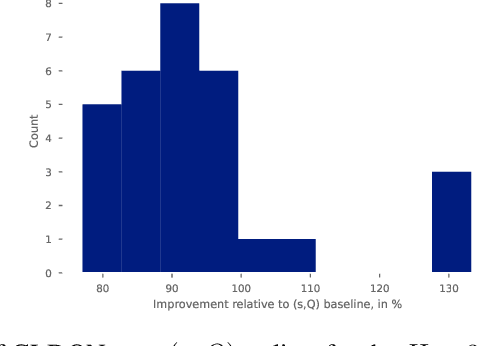
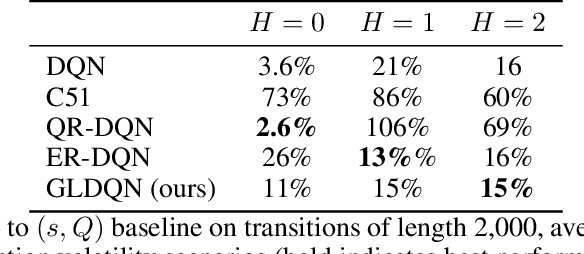
Abstract:We study the problem of restocking a grocery store's inventory with perishable items over time, from a distributional point of view. The objective is to maximize sales while minimizing waste, with uncertainty about the actual consumption by costumers. This problem is of a high relevance today, given the growing demand for food and the impact of food waste on the environment, the economy, and purchasing power. We frame inventory restocking as a new reinforcement learning task that exhibits stochastic behavior conditioned on the agent's actions, making the environment partially observable. We introduce a new reinforcement learning environment based on real grocery store data and expert knowledge. This environment is highly stochastic, and presents a unique challenge for reinforcement learning practitioners. We show that uncertainty about the future behavior of the environment is not handled well by classical supply chain algorithms, and that distributional approaches are a good way to account for the uncertainty. We also present GLDQN, a new distributional reinforcement learning algorithm that learns a generalized lambda distribution over the reward space. We show that GLDQN outperforms other distributional reinforcement learning approaches in our partially observable environments, in both overall reward and generated waste.
A Next Basket Recommendation Reality Check
Sep 29, 2021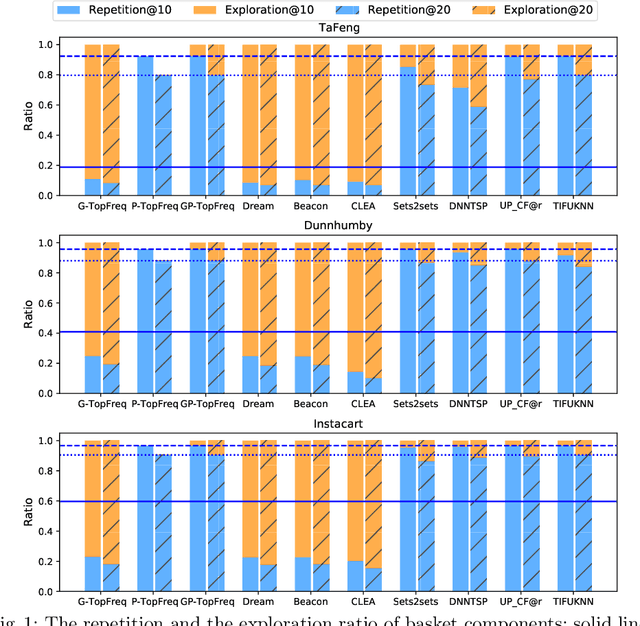
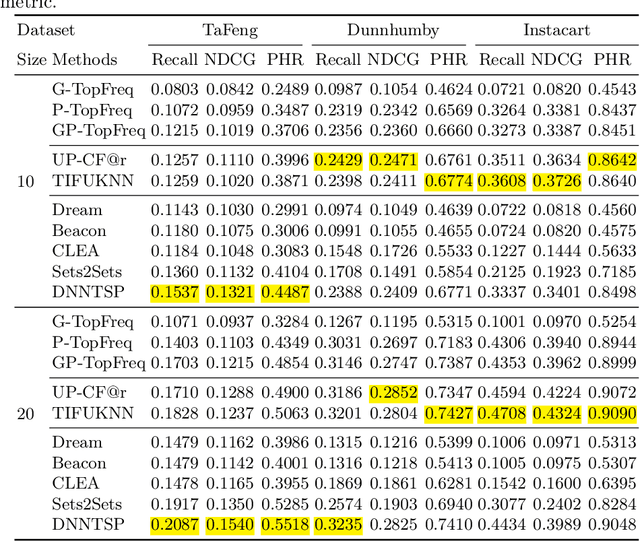
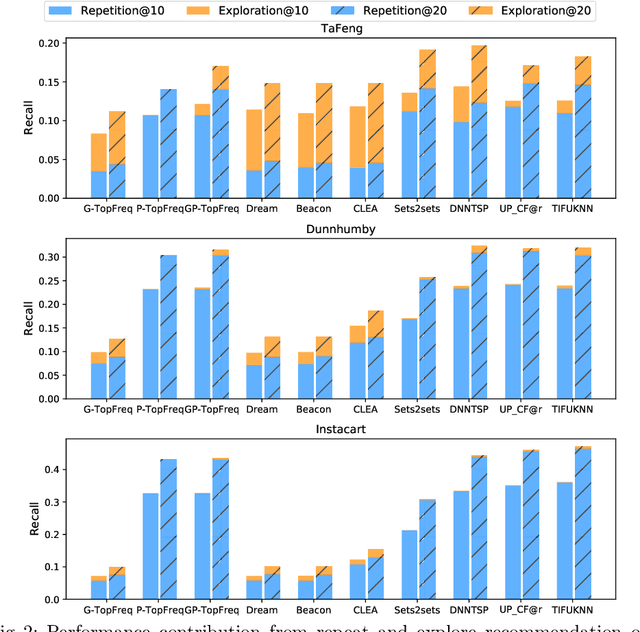
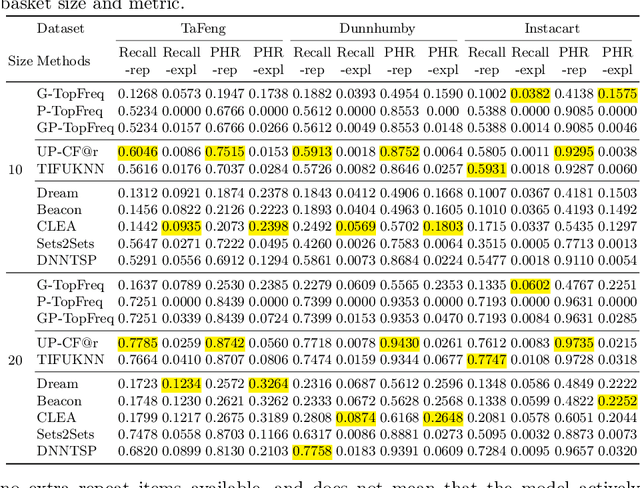
Abstract:The goal of a next basket recommendation (NBR) system is to recommend items for the next basket for a user, based on the sequence of their prior baskets. Recently, a number of methods with complex modules have been proposed that claim state-of-the-art performance. They rarely look into the predicted basket and just provide intuitive reasons for the observed improvements, e.g., better representation, capturing intentions or relations, etc. We provide a novel angle on the evaluation of next basket recommendation methods, centered on the distinction between repetition and exploration: the next basket is typically composed of previously consumed items (i.e., repeat items) and new items (i.e, explore items). We propose a set of metrics that measure the repeat/explore ratio and performance of NBR models. Using these new metrics, we analyze state-of-the-art NBR models. The results of our analysis help to clarify the extent of the actual progress achieved by existing NBR methods as well as the underlying reasons for the improvements. Overall, our work sheds light on the evaluation problem of NBR and provides useful insights into the model design for this task.
 Add to Chrome
Add to Chrome Add to Firefox
Add to Firefox Add to Edge
Add to Edge